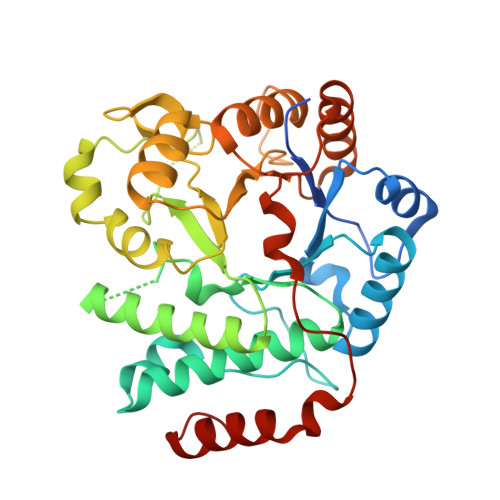Catalytic Cycle of the N-Acetylglucosaminidase NagZ from Pseudomonas aeruginosa.
Acebron, I., Mahasenan, K.V., De Benedetti, S., Lee, M., Artola-Recolons, C., Hesek, D., Wang, H., Hermoso, J.A., Mobashery, S.(2017) J Am Chem Soc 139: 6795-6798
- PubMed: 28482153
- DOI: https://doi.org/10.1021/jacs.7b01626
- Primary Citation of Related Structures:
5G1M, 5G2M, 5G3R, 5G5K, 5G5U, 5G6T, 5LY7 - PubMed Abstract:
The N-acetylglucosaminidase NagZ of Pseudomonas aeruginosa catalyzes the first cytoplasmic step in recycling of muropeptides, cell-wall-derived natural products. This reaction regulates gene expression for the β-lactam resistance enzyme, β-lactamase. The enzyme catalyzes hydrolysis of N-acetyl-β-d-glucosamine-(1→4)-1,6-anhydro-N-acetyl-β-d-muramyl-peptide (1) to N-acetyl-β-d-glucosamine (2) and 1,6-anhydro-N-acetyl-β-d-muramyl-peptide (3). The structural and functional aspects of catalysis by NagZ were investigated by a total of seven X-ray structures, three computational models based on the X-ray structures, molecular-dynamics simulations and mutagenesis. The structural insights came from the unbound state and complexes of NagZ with the substrate, products and a mimetic of the transient oxocarbenium species, which were prepared by synthesis. The mechanism involves a histidine as acid/base catalyst, which is unique for glycosidases. The turnover process utilizes covalent modification of D244, requiring two transition-state species and is regulated by coordination with a zinc ion. The analysis provides a seamless continuum for the catalytic cycle, incorporating large motions by four loops that surround the active site.
- Department of Crystallography and Structural Biology, Institute of Physical Chemistry "Rocasolano", CSIC , 28006 Madrid, Spain.
Organizational Affiliation:


















